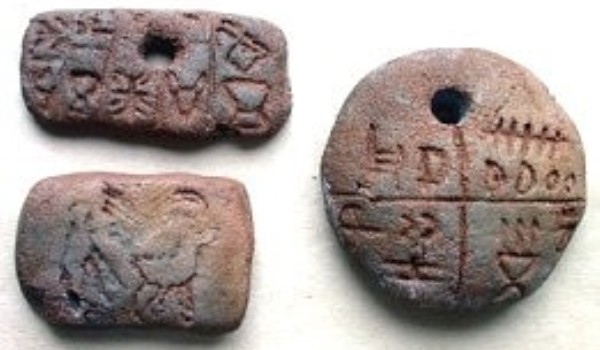Cretan Hieroglyphics
The Ornamental and Ritual Version
of the Cretan Protolinear Script Evangelos C. Papakitsos, Ioannis K. Kenanidis, https://www.researchgate.net/publication/312039048_Cretan_Hieroglyphics_The_Ornamental_and_Ritual_Version_of_the_Cretan_Protolinear_ScriptTable 1
- AB37; Did not show the shape of equivalent proto-cuneiform sign Ti(l)/gis Ti (could be https://cdli.ucla.edu/tools/SignLists/protocuneiform/archsigns/DIN.jpg ?)
-AB08 a symbol of supreme deity, but sumerian sign for supreme deity An, is much different. https://cdli.ucla.edu/tools/SignLists/protocuneiform/archsigns/AN.jpg .The proto-cuneiform signs wich are close to the minoan symbol of supreme deity are :
similar to "A" sign:
https://cdli.ucla.edu/tools/SignLists/protocuneiform/archsigns/GAL~b.jpg
similar to labrys sign:
https://cdli.ucla.edu/tools/SignLists/protocuneiform/archsigns/GA'AR~b1.jpg
https://cdli.ucla.edu/tools/SignLists/protocuneiform/archsigns/ZAG~c.jpg
-AB26 did not show sumerian equivalent; proto-sumerian sign RU has different shape and meaning (me : could be close to sumerian Ru:
The Proto-Sumerian Language Invention Process
Nov 2, 2014 - Paper analyzing the Sumerian proto-language. ... by John A. Halloran ..... ru5: to send forth shoots, buds, or blossoms; to butt; to gore. sa: n.https://cdli.ucla.edu/tools/SignLists/protocuneiform/archsigns/RU.jpg ).Not shown nor “ur2 / uru8” in cuneiform
-AB29.Did not show sumerian Pu2 sign,
Sumerian}
-AB38 did not show the equivalent sumerian sign (me; yes, linguistics sumerian E is building, but you not show the sign shape , see https://cdli.ucla.edu/tools/SignLists/protocuneiform/archsigns/E~b.jpg ; sumerian has an specific sign Ab for "house,temple") https://cdli.ucla.edu/tools/SignLists/protocuneiform/archsigns/AB~a.jpg
Fig.1,2
On the ladder-shape signs: Linear A has the signs "Nu" "Ya" and Pa3, https://blogger.googleusercontent.com/img/b/R29vZ2xl/AVvXsEgLyglaWKvhDTTvHfKWW3xwFyWd7216cc-X465XWioZOkDXJzKlKv0PLxQeFusJWOOm0DhLUw9SsXK4i7gn7ZVW0DLZhAFJepzJ9NlJjTZg5Fld6lEx9qchUdwlKmu-KUJqshoBZERgxGnb/s1600/Linear-A-base.jpg
Proto-cuneiform ladder-signs are : https://cdli.ucla.edu/tools/SignLists/protocuneiform/archsigns/NAM2.jpg
https://cdli.ucla.edu/tools/SignLists/protocuneiform/archsigns/GA2~a3.jpg
and KU https://cdli.ucla.edu/tools/SignLists/protocuneiform/archsigns/KU~a.jpg
A Halloran ku: to base, found, build; to lie down
and K?A/Ga2
https://cdli.ucla.edu/tools/SignLists/protocuneiform/archsigns/GA2~a1.jpg https://cdli.ucla.edu/tools/SignLists/protocuneiform/archsigns/NIGIN.jpg ; ( last twoo are is in horizontal position!)
http://www.oocities.org/proto-language/SumerianArchaicSignTable.htm
K?A
The Sumerian sign (Jaritz #458) depicts a 'tubular basket'; a variant, #458a, tapers toward the top; both have top-covers; both presumably and read ga2 (among others). Another recorded reading for it is pisan, which means 'basket' but perhaps also '*shallow tray' https://scontent.ftsr1-2.fna.fbcdn.net/v/t1.15752-9/43053145_245861412767736_422670673651957760_n.jpg?_nc_cat=107&_nc_ht=scontent.ftsr1-2.fna&oh=f901efe7f54c1a6b05a59eba137ffd09&oe=5C5134D6
Fig.3
Sign Linear B 45.You did not find a close shape of pre-cuneiform sign. It has the exact shape in proto-cuneiform sign SA https://cdli.ucla.edu/tools/SignLists/protocuneiform/archsigns/SZA.jpg (f Sumerian Logograms by John A. Halloran ...... szá-l thread, string ;Sa"to dry up")
On decipherment exemple am reserved.
Proto-cuneiform signs from https://cdli.ucla.edu/tools/SignLists/protocuneiform/archsigns.html
-----------------------------------------------------------------------------------------------------
On Additional Palaeographic Evidence for the Relationship of the Aegean Scripts to the Sumerian Pictography Evangelos C. Papakitsos*1 , Ioannis K. Kenanidis2 http://saspjournals.com/wp-content/uploads/2015/06/SJAHSS-33C734-737.pdf
Fig-1. Sign *8 (“a”)Linear B sign "A"
Of course sign A is related to proto-sumerian signs Ga'ar and Zag, but not direct relation.Direct relation could be with sign https://cdli.ucla.edu/tools/SignLists/protocuneiform/archsigns/GESZTU~a.jpg. It is much direct to labrys than to the sign "A".
Fig-1. Sign *57 (“ja”)
Yes. Probably the sign you are reffering to, is https://cdli.ucla.edu/tools/SignLists/protocuneiform/archsigns/GA2~a3.jpg
Sign *4 Fig-2. The sign forms for syllable te.
Yes, the proto-cuneiform equivalent is sign "Se" /Sze https://cdli.ucla.edu/tools/SignLists/protocuneiform/archsigns/SZE~a@t.jpg
Sign *6 Fig-3. The sign forms for syllable na.
? Much close, https://cdli.ucla.edu/tools/SignLists/protocuneiform/archsigns/NUN~b.jpg ?
Sign *10 Fig-4. The sign forms for syllable u.
Your proposal not satisfactory.
No close match
? https://cdli.ucla.edu/tools/SignLists/protocuneiform/archsigns/BA.jpg
https://cdli.ucla.edu/tools/SignLists/protocuneiform/archsigns/ZATU694~c.jpg ?
Sign *25 Fig-5. The sign forms for syllable ha.
Not convincing.
? https://cdli.ucla.edu/tools/SignLists/protocuneiform/archsigns/GESZTU~a.jpg
https://cdli.ucla.edu/tools/SignLists/protocuneiform/archsigns/ERIM~a.jpg
https://cdli.ucla.edu/tools/SignLists/protocuneiform/archsigns/BIR3~b.jpg ?
Sign *31 Fig-6. The sign forms for syllable sa.
Not convincing.
Better https://cdli.ucla.edu/tools/SignLists/protocuneiform/archsigns/BAD.jpg
Sign *39 Fig-7. The sign forms for syllable pi.
Not convincing
? https://cdli.ucla.edu/tools/SignLists/protocuneiform/archsigns/GESZTIN~c.jpg
https://cdli.ucla.edu/tools/SignLists/protocuneiform/archsigns/IGI.jpg
https://cdli.ucla.edu/tools/SignLists/protocuneiform/archsigns/USZ~b.jpg ?
Sign *59 Fig-8. The sign forms for syllable ta.
What proto-cuneiform sign is?
? https://cdli.ucla.edu/tools/SignLists/protocuneiform/archsigns/MA2.jpg ?
This is the sign : https://cdli.ucla.edu/tools/SignLists/protocuneiform/archsigns/ZATU625.jpg
Sign *66 Fig-9. The sign forms for syllable tə (“ta2”).
Think no, better:
https://cdli.ucla.edu/tools/SignLists/protocuneiform/archsigns/BIR~b.jpg
https://cdli.ucla.edu/tools/SignLists/protocuneiform/archsigns/KAR2~b.jpg
Sign *73 Fig-10. The sign forms for syllable mi.
Did not show sumerian sign.
It is: https://cdli.ucla.edu/tools/SignLists/protocuneiform/archsigns/SZU.jpg
Maybe better https://cdli.ucla.edu/tools/SignLists/protocuneiform/archsigns/TAK4~a@n.jpg
Sign *74 Fig-11. The sign forms for syllable ze
? https://cdli.ucla.edu/tools/SignLists/protocuneiform/archsigns/DA~c.jpg
https://cdli.ucla.edu/tools/SignLists/protocuneiform/archsigns/TAG~a1@t.jpg ?
Sign *77 Fig-12. The sign forms for syllable ca/ka.
Sumerian sign for sheep.yes, http://www.newsnfo.co.uk/images%202/sumerian%20and%20cuneiform%20writing%20sheep%20referance.jpg , but the name of the sign is UDU: https://cdli.ucla.edu/tools/SignLists/protocuneiform/archsigns/UDU~b.jpg
https://static.cambridge.org/resource/id/urn:cambridge.org:id:binary:17706:20160804090558862-0668:03648fig5_9.png?pub-status=live
Sign *80 Fig-13. The sign forms for syllable ma
No coments. Note that there was another proto-cuneiform sign close to the AMAR/calf shape, for "...goat"
MAH 15887: Animal Husbandry and Animal Paleography
/ Emmert Clevenstine https://encrypted-tbn0.gstatic.com/images?q=tbn:ANd9GcTUBh5MTthTsPc13bYgyFRpHt6i5T_47HFjBJFzbRjcyEQ3RkiJ
